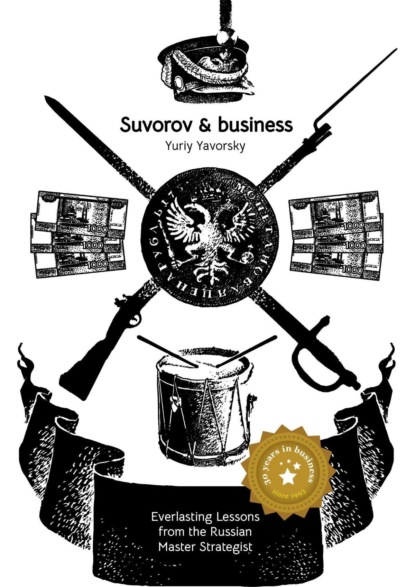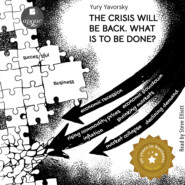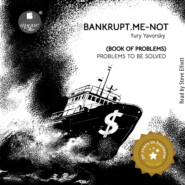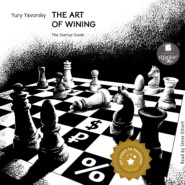По всем вопросам обращайтесь на: info@litportal.ru
(©) 2003-2024.
✖
Suvorov & business. Everlasting lessons from the russian master strategist
Автор
Год написания книги
2018
Настройки чтения
Размер шрифта
Высота строк
Поля
Suvorov & business. Everlasting lessons from the russian master strategist
Yury Yavorsky
Alexander Suvorov, Russian military general, is known to have spoken seven languages, including Turkish and Finnish, was an expert in military history, a brilliant mathematician, and never lost a single battle.Some ideas of the famous general will be considered in this book through the prism of the business environment. I hope that entrepreneurs will appreciate the parallels drawn and will learn a lot of useful lessons from Suvorov’s covenants.
Suvorov & business. Everlasting lessons from the russian master strategist
Yury Yavorsky
Translator Irina Nikitina
Illustrator Ivan Kremenetsky
Project manager Alexey Perevedentsev
© Yury Yavorsky, 2019
ISBN 978-5-4490-6839-2
Created with Ridero smart publishing system
All rights reserved. No part of the electronic version of this book may be reproduced in any form or by any means, including posting on the Internet and in corporate networks, for private and public use without a written permission of the copyright owner.
Author’s website: http://yavorsky.biz (http://yavorsky.biz/)
Here lies the wisdom of centuries old
Here flows the firmness of valiant hearts,
Here saves, with deep devotion, father
All that he wishes for his son!
Alexander Suvorov
PART ONE. ACT OUTSIDE THE BOX!
Preface
Alexander Suvorov, Russian military general, is known to have spoken seven languages, including Turkish and Finnish, was an expert in military history, a brilliant mathematician, and never lost a single battle.
Wisdom of the distinguished strategist and tactician of military art can find practical application in any business. Suvorov’s strategy is the key to success.
Some ideas of the famous general will be considered in this book through the prism of the business environment. I hope that entrepreneurs will appreciate the parallels drawn and will learn many useful lessons from Suvorov’s covenants.
– Yury Yavorsky
Alexander Suvorov:
In none of your actions whatsoever shall you plainly reveal your ambitions:
– charge at a bear with a heavy hunting spear
– do never flush a wolf with no surround ready
– where determined to prevail expending minimal resources, set a baited snare or arrange a trap.
Charge at a bear with a heavy hunting spear
Here is my take on these instructions: an entrepreneur should be very particular about disguising their plans and the tactical scheme of their future business moves aimed at conquering the market. Also required is a clear perspective on the size, capabilities, and behavior of adversaries. A completely different course of action is necessary for each of all competitors: some you would charge head on with a bear spear, with others you would choose to elegantly outmaneuver.
Do never flush a wolf with no surround ready
Over my twenty-five years in business, there were many cases where I had to deploy a whole range of methods when bringing a single new product or service on the market. I have learned for a fact that the ways of an entrepreneur should be akin to the ways of a hunter who is out in the dark in the vast expanse of a wood or mountains. He never knows what the “beast” -competitor has been plotting, or what surprises are there in the “thicket” of the market, or whether the vision of the “hunting” entrepreneur will “feed” him, his family, and his team, or whether he will be able to get enough “meat” to last him until the next fortunate “bag of game”.
Trap with a decoy
Baited snare
…In the 1990s, my company manufactured dashboards for passenger vehicles. Browsing car spares at a marketplace, I once stumbled upon a seller who had on offer assembled dashboards complete with a full set of instruments, including the wiring for all requisite connections to other car parts. Then I wondered how many elements there are in a dashboard anyway? The answer was just over a hundred. The next step was to get quotes for all those component parts individually. (That was the time when vendors sold spares in the open, literally in a field, laying out their merchandise straight on the ground or on small tables; quite similar to what one sees at flea markets today). When I added up all the prices, the grand total came to 400 rubles, no higher, whereas a complete dashboard sold at 800 rubles. I procured all the components, assembled a dashboard at home, and sold it having doubled my capital. It would appear to be an ultimate success story. However, I came to realize that everybody was doing just the same: that marketplace had four other crews. So I decided to use the principles of supply chain management and barter economy, or take a “holistic approach”, as they might call it today.
I found out that dashboard clocks were supplied from Minsk (1,300 km), speed meters came from Vladimir (200 km), and so forth. In short, all the components had to be shipped from other cities, as there was no local production in Nizhny Novgorod. Having asked around at various factories, I saw I could “trim the fat” off the dashboard cost down to 200 rubles. Then, at the marketplace, I offered vendors who carried speed meters to swap two meters for one clock; I was getting those clocks by going to Minsk myself. I arranged with other sellers to exchange plastic parts that I was buying in a town near Nizhny Novgorod for rubber parts, which some sold by weight, not by piece. My partners were able to expand their product range with no additional investment, and I was able to drive the dashboard cost down.
At a cost of 100 rubles, I started selling the dashboards for 400 rubles at new sales outlets that bore no relation to me at all.
This made all four of my competitors cease assembly operations. I understood that they would need two to three months to regroup and resume dashboard production. I decided to go with the four-hundred-ruble offer for a bit longer and, at the same time, to limit the supply to one or two units per day, forcing sellers to take pre-orders and create lines, what people today might call “generating deferred demand”… After one month, I started raising the price by 100 rubles every week. Even at a 1,200-ruble quote, I was getting a few months’ worth of pre-orders.
My competitors never saw what was coming though. They were simply happy that dashboards were selling for RUB 1,200, resumed their make-shift assembly operations, and set similar prices. Today these recollections cannot but make me smile. After a while, I played out the very same formula again, and the competition allowed me, again, to establish a temporary monopoly for a couple of months. The profits that an entrepreneur makes within this short period can be several times higher than regular profits of one or even two years.
I am always in control of production costs at my workshops. This applies to each and every item, be it a small component, like a run-flat tire insert that we sell to a partner, or a complete armored vehicle. And I always try to work out the costs of my potential competitors.
…I once got involved into a tender with a competitor. At that time, my company already had own production facilities and manufactured bulletproof glass, used laser cutting systems for armor plates, produced thousands of other components and parts; our competitor, on the other hand, was basically buying components and assembling armored vehicles.
It was quite easy to calculate that his cars, which would be competing against our armored vehicle, cost RUB 2.8 million each to produce. Unfortunately, the bids in that tender were not evaluated on product quality, brand history, or prior successful contracts. It was all about the price. And it all came down to two principal objectives: not to sell below our usual price, or we would have to stick to that price going forward; but also to outsmart the competitor. I had to begrudgingly lower the bar and strip the vehicle of some one-of-the-kind, patented options that only our company could offer. That made it possible to bring the cost all the way down to RUB 2.1 million.
The tender opened at RUB 3.8 million, the price gradually slipping down and sometimes stalling, so far as was reasonable for Internet bidding. Our bids were lightning fast to show that we did not hesitate to drop the price; our competitor was faltering, each new bid taking longer. The longest halt came at RUB 3.1 million. We bid down once again and at RUB 2.9 million, the tender was ours.
…During another tender, for low-margin cash-in-transit vans I was able to do exactly the opposite. It was clear that the two other participants would fight to the bitter end; after all, the prize was an order for armored vans for a major Russian bank. A contract like this can easily mean full capacity utilization for 5—6 months even for a heavyweight.
In my operation, however, I have always valued profit margins over production output. To digress for a moment, I see that many start a business with a totally inexplicable vision in mind. For example, one of my competitors ran a company with profits lower than his employees’ pay and firmly maintained that the ultimate goal of business was to provide jobs and that he would never sack anybody. His business run was short: he dismissed everybody and left the market.
Back to the tender now, we did apply along with the others. I knew my production costs to the penny and had a rough idea of my competitors’ costs. Our companies differed in size. I employed three times as many staff, relied on own production of bulletproof glass, had laser cutting systems and CNC machines, and manufactured thousands of components in-house. The competitors preferred to buy up from numerous suppliers, which chipped away at potential profits and added to costs. With an average CIT armored van going for RUB 700,000—800,000, their production costs stood at RUB 550,000. Our cost was just under RUB 460,000.
The tender opened at RUB 770,000 and quickly reached RUB 670,000. We were silently biding the time. The downward trend started to slow down and halted at RUB 580,000. This would seem to be as low as it would go… We bid at RUB 570,000. Time passed. I was getting anxious: had I miscalculated? The thing was I did not want that contract. It would have taken over the production line with low-margin vehicles and prevent us from making complex VIP armored cars at a high profit, no Mercedes, no Lexus or the like…
The tender was seconds from closing when a RUB 560,000 bid came in and I was off the hook – it worked! I was able to ensnare a competitor into a low-margin contract that would not be profitable and, most importantly, close him off the VIP armored cars market that he had been aiming for. This was a long-term victory.
But that was not the end of the story. The winning bidder pleaded with the bank to top up the price by at least 10%. Failing to get that, he turned to his competitor asking for help to make good on the contract. The bank agreed to have two suppliers. At the end of the day, my two competitors first wrestled, plummeting the price to barely top the cost, and then ended up together in the low-margin segment where they ran down their production facilities and wasted time. And I used that time to conquer the VIP segment.
To this day, the RIDA-branded armored vehicles from Russia are known for their quality build and protection on a par with global big-league brands, such as GARD in Germany or CARAT in Belgium; RIDA armored vehicles sell to dozens of countries in the Middle East, Asia, Europe, and Africa.
Yury Yavorsky
Alexander Suvorov, Russian military general, is known to have spoken seven languages, including Turkish and Finnish, was an expert in military history, a brilliant mathematician, and never lost a single battle.Some ideas of the famous general will be considered in this book through the prism of the business environment. I hope that entrepreneurs will appreciate the parallels drawn and will learn a lot of useful lessons from Suvorov’s covenants.
Suvorov & business. Everlasting lessons from the russian master strategist
Yury Yavorsky
Translator Irina Nikitina
Illustrator Ivan Kremenetsky
Project manager Alexey Perevedentsev
© Yury Yavorsky, 2019
ISBN 978-5-4490-6839-2
Created with Ridero smart publishing system
All rights reserved. No part of the electronic version of this book may be reproduced in any form or by any means, including posting on the Internet and in corporate networks, for private and public use without a written permission of the copyright owner.
Author’s website: http://yavorsky.biz (http://yavorsky.biz/)
Here lies the wisdom of centuries old
Here flows the firmness of valiant hearts,
Here saves, with deep devotion, father
All that he wishes for his son!
Alexander Suvorov
PART ONE. ACT OUTSIDE THE BOX!
Preface
Alexander Suvorov, Russian military general, is known to have spoken seven languages, including Turkish and Finnish, was an expert in military history, a brilliant mathematician, and never lost a single battle.
Wisdom of the distinguished strategist and tactician of military art can find practical application in any business. Suvorov’s strategy is the key to success.
Some ideas of the famous general will be considered in this book through the prism of the business environment. I hope that entrepreneurs will appreciate the parallels drawn and will learn many useful lessons from Suvorov’s covenants.
– Yury Yavorsky
Alexander Suvorov:
In none of your actions whatsoever shall you plainly reveal your ambitions:
– charge at a bear with a heavy hunting spear
– do never flush a wolf with no surround ready
– where determined to prevail expending minimal resources, set a baited snare or arrange a trap.
Charge at a bear with a heavy hunting spear
Here is my take on these instructions: an entrepreneur should be very particular about disguising their plans and the tactical scheme of their future business moves aimed at conquering the market. Also required is a clear perspective on the size, capabilities, and behavior of adversaries. A completely different course of action is necessary for each of all competitors: some you would charge head on with a bear spear, with others you would choose to elegantly outmaneuver.
Do never flush a wolf with no surround ready
Over my twenty-five years in business, there were many cases where I had to deploy a whole range of methods when bringing a single new product or service on the market. I have learned for a fact that the ways of an entrepreneur should be akin to the ways of a hunter who is out in the dark in the vast expanse of a wood or mountains. He never knows what the “beast” -competitor has been plotting, or what surprises are there in the “thicket” of the market, or whether the vision of the “hunting” entrepreneur will “feed” him, his family, and his team, or whether he will be able to get enough “meat” to last him until the next fortunate “bag of game”.
Trap with a decoy
Baited snare
…In the 1990s, my company manufactured dashboards for passenger vehicles. Browsing car spares at a marketplace, I once stumbled upon a seller who had on offer assembled dashboards complete with a full set of instruments, including the wiring for all requisite connections to other car parts. Then I wondered how many elements there are in a dashboard anyway? The answer was just over a hundred. The next step was to get quotes for all those component parts individually. (That was the time when vendors sold spares in the open, literally in a field, laying out their merchandise straight on the ground or on small tables; quite similar to what one sees at flea markets today). When I added up all the prices, the grand total came to 400 rubles, no higher, whereas a complete dashboard sold at 800 rubles. I procured all the components, assembled a dashboard at home, and sold it having doubled my capital. It would appear to be an ultimate success story. However, I came to realize that everybody was doing just the same: that marketplace had four other crews. So I decided to use the principles of supply chain management and barter economy, or take a “holistic approach”, as they might call it today.
I found out that dashboard clocks were supplied from Minsk (1,300 km), speed meters came from Vladimir (200 km), and so forth. In short, all the components had to be shipped from other cities, as there was no local production in Nizhny Novgorod. Having asked around at various factories, I saw I could “trim the fat” off the dashboard cost down to 200 rubles. Then, at the marketplace, I offered vendors who carried speed meters to swap two meters for one clock; I was getting those clocks by going to Minsk myself. I arranged with other sellers to exchange plastic parts that I was buying in a town near Nizhny Novgorod for rubber parts, which some sold by weight, not by piece. My partners were able to expand their product range with no additional investment, and I was able to drive the dashboard cost down.
At a cost of 100 rubles, I started selling the dashboards for 400 rubles at new sales outlets that bore no relation to me at all.
This made all four of my competitors cease assembly operations. I understood that they would need two to three months to regroup and resume dashboard production. I decided to go with the four-hundred-ruble offer for a bit longer and, at the same time, to limit the supply to one or two units per day, forcing sellers to take pre-orders and create lines, what people today might call “generating deferred demand”… After one month, I started raising the price by 100 rubles every week. Even at a 1,200-ruble quote, I was getting a few months’ worth of pre-orders.
My competitors never saw what was coming though. They were simply happy that dashboards were selling for RUB 1,200, resumed their make-shift assembly operations, and set similar prices. Today these recollections cannot but make me smile. After a while, I played out the very same formula again, and the competition allowed me, again, to establish a temporary monopoly for a couple of months. The profits that an entrepreneur makes within this short period can be several times higher than regular profits of one or even two years.
I am always in control of production costs at my workshops. This applies to each and every item, be it a small component, like a run-flat tire insert that we sell to a partner, or a complete armored vehicle. And I always try to work out the costs of my potential competitors.
…I once got involved into a tender with a competitor. At that time, my company already had own production facilities and manufactured bulletproof glass, used laser cutting systems for armor plates, produced thousands of other components and parts; our competitor, on the other hand, was basically buying components and assembling armored vehicles.
It was quite easy to calculate that his cars, which would be competing against our armored vehicle, cost RUB 2.8 million each to produce. Unfortunately, the bids in that tender were not evaluated on product quality, brand history, or prior successful contracts. It was all about the price. And it all came down to two principal objectives: not to sell below our usual price, or we would have to stick to that price going forward; but also to outsmart the competitor. I had to begrudgingly lower the bar and strip the vehicle of some one-of-the-kind, patented options that only our company could offer. That made it possible to bring the cost all the way down to RUB 2.1 million.
The tender opened at RUB 3.8 million, the price gradually slipping down and sometimes stalling, so far as was reasonable for Internet bidding. Our bids were lightning fast to show that we did not hesitate to drop the price; our competitor was faltering, each new bid taking longer. The longest halt came at RUB 3.1 million. We bid down once again and at RUB 2.9 million, the tender was ours.
…During another tender, for low-margin cash-in-transit vans I was able to do exactly the opposite. It was clear that the two other participants would fight to the bitter end; after all, the prize was an order for armored vans for a major Russian bank. A contract like this can easily mean full capacity utilization for 5—6 months even for a heavyweight.
In my operation, however, I have always valued profit margins over production output. To digress for a moment, I see that many start a business with a totally inexplicable vision in mind. For example, one of my competitors ran a company with profits lower than his employees’ pay and firmly maintained that the ultimate goal of business was to provide jobs and that he would never sack anybody. His business run was short: he dismissed everybody and left the market.
Back to the tender now, we did apply along with the others. I knew my production costs to the penny and had a rough idea of my competitors’ costs. Our companies differed in size. I employed three times as many staff, relied on own production of bulletproof glass, had laser cutting systems and CNC machines, and manufactured thousands of components in-house. The competitors preferred to buy up from numerous suppliers, which chipped away at potential profits and added to costs. With an average CIT armored van going for RUB 700,000—800,000, their production costs stood at RUB 550,000. Our cost was just under RUB 460,000.
The tender opened at RUB 770,000 and quickly reached RUB 670,000. We were silently biding the time. The downward trend started to slow down and halted at RUB 580,000. This would seem to be as low as it would go… We bid at RUB 570,000. Time passed. I was getting anxious: had I miscalculated? The thing was I did not want that contract. It would have taken over the production line with low-margin vehicles and prevent us from making complex VIP armored cars at a high profit, no Mercedes, no Lexus or the like…
The tender was seconds from closing when a RUB 560,000 bid came in and I was off the hook – it worked! I was able to ensnare a competitor into a low-margin contract that would not be profitable and, most importantly, close him off the VIP armored cars market that he had been aiming for. This was a long-term victory.
But that was not the end of the story. The winning bidder pleaded with the bank to top up the price by at least 10%. Failing to get that, he turned to his competitor asking for help to make good on the contract. The bank agreed to have two suppliers. At the end of the day, my two competitors first wrestled, plummeting the price to barely top the cost, and then ended up together in the low-margin segment where they ran down their production facilities and wasted time. And I used that time to conquer the VIP segment.
To this day, the RIDA-branded armored vehicles from Russia are known for their quality build and protection on a par with global big-league brands, such as GARD in Germany or CARAT in Belgium; RIDA armored vehicles sell to dozens of countries in the Middle East, Asia, Europe, and Africa.











